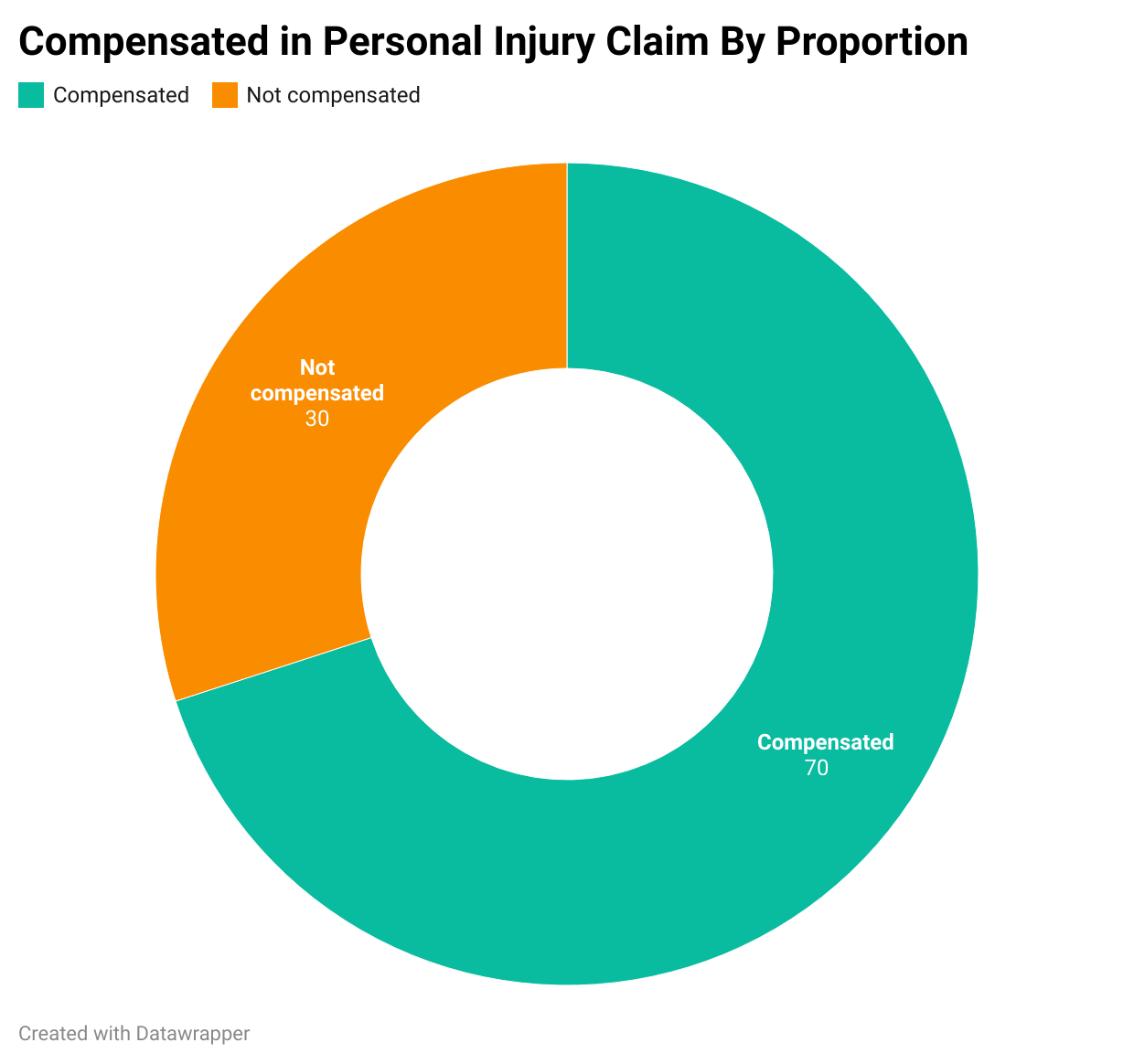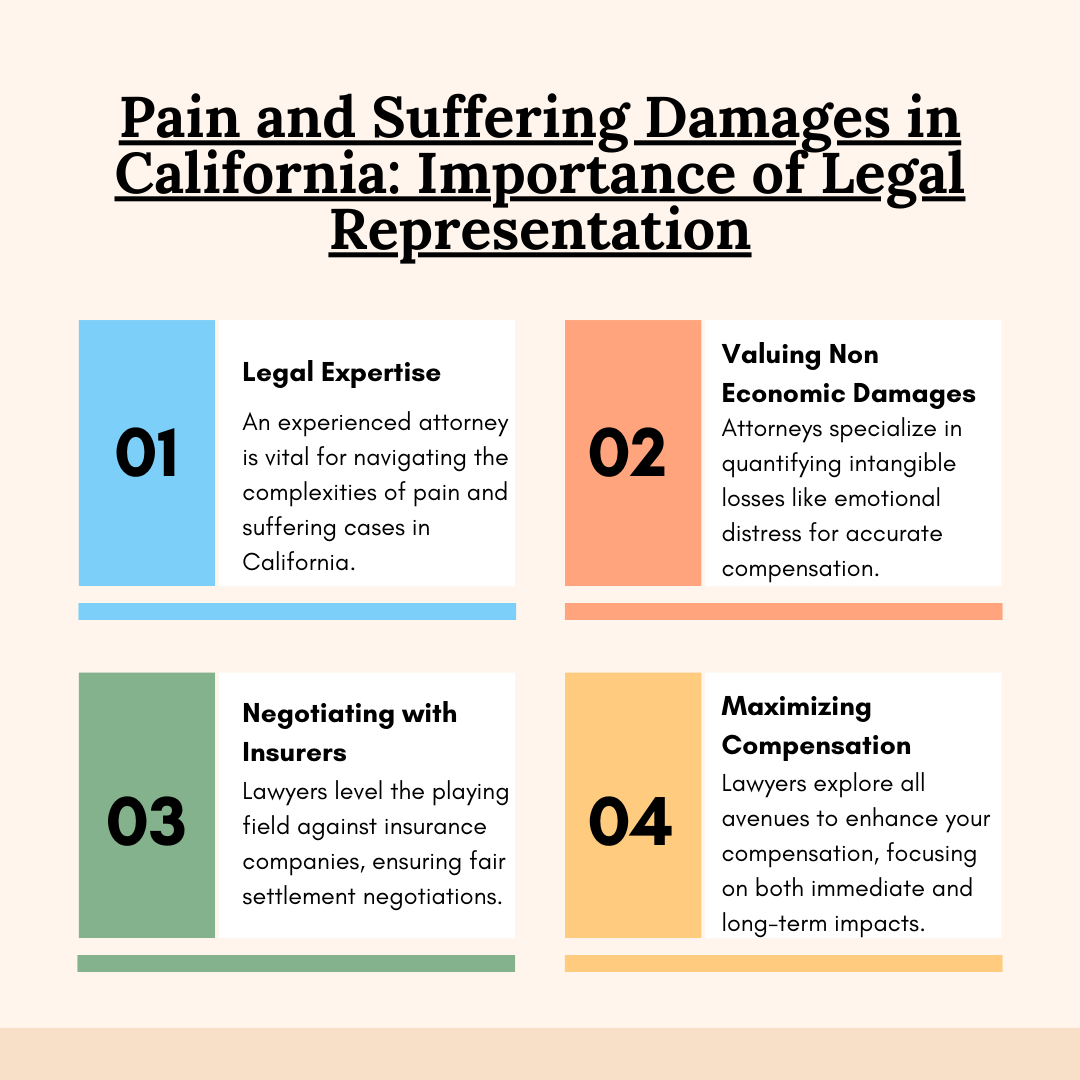In the US, there are 39.5 million cases of personal injury each year that require medical attention, or around 126.3 cases per 1000 people. Navigating the aftermath of an injury can be daunting, especially in California, where the legal paths to compensation are as wide-ranging as the state itself. Pain and suffering damages in California are unique because they recognize the part of your experience that isn’t easily quantified: the emotional turmoil and physical pain that doesn’t come with a clear price tag.
The journey through California’s legal system, with its complex rules and nuanced cases, highlights the importance of understanding how your suffering is measured and compensated. Whether it’s knowing how your pain and suffering are valued, the legal rules that will affect your case, or the importance of choosing the right attorney, being informed is crucial.
This article explores the legal framework behind pain and suffering damages in California, the factors that influence these, and the importance of legal representation in such cases.
- Understanding Pain and Suffering Damages in California
- Pain and Suffering Damages in California: Legal Framework
- Calculating Pain and Suffering Damages in California
- Factors That Influence the Pain and Suffering Damages Calculation in California
- Pain and Suffering Damages in California: Common Legal Scenarios
- Importance of Legal Representation When Suing for Pain and Suffering Damages in California
- Frequently Asked Questions
Understanding Pain and Suffering Damages in California
When discussing legal compensation in California, “pain and suffering damages” play an important role, particularly in personal injury cases. These damages are meant to offer financial relief for the physical pain and emotional distress you’ve endured due to an injury that wasn’t your fault.
70% of those who filed a personal injury claim were compensated, which could be either through a trial or settlement. Unlike the more straightforward economic damages that cover bills and lost wages, pain and suffering damages address the non-tangible, often more personal consequences of an accident.


Difference Between Economic and Non-Economic Damages
In personal injury law, damages are generally categorized into two types: economic and non-economic.
- Economic damages are the tangible, monetary losses you’ve incurred as a direct result of your injury. These can include medical bills, rehabilitation costs, lost wages, and any other quantifiable financial impacts.
- Non-economic damages, on the other hand, cover the intangible effects of your injury. This is where pain and suffering damages come into play, alongside the loss of enjoyment of life, emotional distress, and loss of consortium.
If you’ve suffered an injury in California, you deserve full compensation for both your physical and emotional suffering. The Personal Injury Center can link you with legal experts dedicated to securing the compensation you need. Reach out for a free evaluation today!
Pain and Suffering Damages in California: Legal Framework
In California, the legal landscape surrounding pain and suffering damages is shaped by specific statutes and reforms. Understanding these legal foundations is crucial for navigating your rights and potential compensation following an injury.
California Civil Code Section 3333
Under California Civil Code Section 3333, if someone’s negligence causes you harm, you’re entitled to recover damages that compensate for your suffering. This includes monetary compensation for both the physical pain and emotional distress you experience as a result of the injury. It’s a broad provision that serves as the cornerstone for most personal injury claims in California, ensuring victims receive the justice and financial support they need to heal.
Medical Injury Compensation Reform Act (MICRA)
The Medical Injury Compensation Reform Act (MICRA) specifically addresses pain and suffering damages in medical malpractice cases in California. It notably caps non-economic damages, including those for pain and suffering, at $250,000.
This means that no matter the severity of your suffering or the negligence level, the compensation you can receive for non-economic damages in a medical malpractice case is limited, a fact that underscores the importance of understanding the specific nuances of your claim.
Proposition 213 (Civil Code Section 3333.4)
Proposition 213, embodied in Civil Code Section 3333.4, imposes restrictions on recovering pain and suffering damages in auto accidents for drivers without insurance, under the influence, or committing a felony during the accident. Essentially, if you fall into one of these categories, your ability to claim these damages may be limited or nullified, emphasizing the need for responsible and lawful behavior on the road to protect your rights.
Comparative Negligence (California Civil Code Section 1431.2)
California’s comparative negligence law, found in Civil Code Section 1431.2, allows for the allocation of fault among all parties involved in an accident. This means your compensation for pain and suffering can be reduced by your percentage of fault in causing the injury.
Understanding this principle is vital, as it directly affects the amount of compensation you can receive, highlighting the importance of a strong legal strategy to minimize your assigned fault in complex cases.
Calculating Pain and Suffering Damages in California


Determining the value of pain and suffering damages in California involves subjective judgment and specific methodologies. Knowing these can help you gauge the potential compensation for your ordeal.
Multiplier Method
The multiplier approach determines compensation for pain and suffering by applying a specific multiplier to your tangible losses, such as medical expenses and lost income. This multiplier, typically ranging from 1 to 5, reflects the severity and impact of your injuries.
For instance, a more severe and life-altering injury would warrant a higher multiplier. This method underscores the interconnectedness of your physical and non-economic experiences, allowing for a more holistic view of your suffering in monetary terms.
Per Diem Approach
The per diem approach assigns a daily rate to your pain and suffering, then multiplies this rate by the number of days you’ve been affected by your injury until you reach maximum medical improvement. This method hinges on the idea that your suffering can be quantified daily, providing a tangible measure of something inherently subjective.
It asks the question, “What is a day of your pain worth?” and then applies this value throughout your recovery, offering a clear, day-by-day account of your pain and suffering for compensation purposes.
Factors That Influence the Pain and Suffering Damages Calculation in California
Navigating the complexities of pain and suffering damages in California requires an understanding of the factors that affect their calculation. These elements are critical in ensuring you receive fair compensation reflective of your ordeal.
- Severity of the Injury: More severe injuries typically result in higher pain and suffering damages, as they are likely to cause greater physical pain and emotional distress.
- Impact on the Victim’s Life: The extent to which an injury affects your daily life, including your ability to work, engage in hobbies, and maintain relationships, significantly influences the compensation amount.
- Duration of Recovery: Longer recovery times often lead to higher compensation for pain and suffering, as prolonged physical and emotional healing processes intensify the victim’s suffering.
- Permanent Consequences: Injuries resulting in permanent disabilities or disfigurements increase the damages awarded for pain and suffering, reflecting the lifelong impact on the victim.
- Emotional and Psychological Effects: The presence of emotional and psychological trauma, such as anxiety, depression, or PTSD, resulting from the injury also plays a critical role in determining the amount of pain and suffering damages.
Pain and Suffering Damages in California: Common Legal Scenarios


In California, pain and suffering damages arise in various scenarios, each bringing its complexities. Understanding these contexts can help you navigate your claim more effectively.
Auto Accidents
Auto accidents are a leading cause of personal injury claims in California, where the consequences often extend beyond physical injuries. If you’re involved in such an accident, you may be entitled to pain and suffering damages for the emotional distress and physical discomfort that follow. This compensation is crucial for addressing the full impact of the accident on your life, covering everything from the immediate shock and trauma to long-term anxieties about driving or getting back into a vehicle.
Medical Malpractice
Medical malpractice cases in California can lead to significant pain and suffering damages, given the deep trust placed in healthcare providers. When this trust is breached due to negligence, resulting in injury or worsened conditions, you’re faced with not just physical repercussions but also profound emotional distress.
The betrayal of trust, coupled with the daunting journey of recovery or adjustment to a new way of living, underscores the necessity of seeking compensation for pain and suffering in these cases.
Product Liability
Product liability claims involve injuries caused by defective or unsafe products. In California, if you’re harmed by such a product, you can pursue pain and suffering damages as part of your claim. These damages acknowledge the physical pain and emotional suffering endured as a result of using a product you believed was safe.
From household appliances to children’s toys or medical devices, the impact of these injuries can reverberate through every aspect of your life, making it essential to recognize and compensate for the full breadth of your suffering.
Importance of Legal Representation When Suing for Pain and Suffering Damages in California
Securing knowledgeable legal representation can be crucial in navigating the complexities of pain and suffering damages cases in California. An experienced attorney can significantly influence the outcome of your claim.


Expertise in Valuing Non-Economic Damages
A lawyer specializing in personal injury cases brings critical expertise in accurately valuing non-economic damages, including pain and suffering. They understand the nuances of how to quantify the intangible aspects of your claim, such as emotional distress and loss of enjoyment of life.
With their experience, they can build a compelling case that accurately represents the full scope of your suffering, ensuring that the compensation you seek reflects the true extent of your damages.
Negotiation with Insurance Companies
Dealing with insurance companies can be daunting, and they often employ strategies to minimize your compensation. Having a lawyer by your side levels the playing field. Your attorney knows the tactics insurance companies use and how to negotiate effectively to protect your interests.
They act as your advocate, fighting to secure a fair settlement that covers both your economic and non-economic damages, ensuring that your recovery and well-being are prioritized.
Facing the aftermath of an injury can be overwhelming. Ensure you’re not under-compensated for your pain and suffering. The Personal Injury Center offers access to top-notch legal representation in California. Contact us to find an advocate for your rights.
Litigation Experience
Should your case go to trial, an attorney with litigation experience becomes indispensable. They know how to navigate the court system, present evidence compellingly, and argue your case before a judge or jury.
Their expertise in litigating pain and suffering damages cases in California can make a significant difference in the outcome, providing you with the representation necessary to achieve a favorable verdict.
Maximizing Compensation


Ultimately, the goal of hiring an attorney is to maximize your compensation. An experienced lawyer can strategically approach your case from multiple angles, ensuring that every potential avenue for recovery is explored.
They understand how to present your case in a manner that highlights the full impact of your injuries on your life, thereby maximizing your potential for receiving substantial pain and suffering damages. This comprehensive approach ensures that you are not only compensated for your immediate losses but also for the long-term effects of your injuries.
California’s legal landscape is complex, but your path to recovery doesn’t have to be. The Personal Injury Center connects you with legal professionals who understand how to navigate your claim for pain and suffering damages. Secure your future by reaching out today.
Key Takeaways
|
Frequently Asked Questions
How to calculate damages for pain and suffering in California?
Damages are often calculated using the multiplier method or per diem approach, factoring in the severity of injuries and their impact on daily life
What is covered in pain and suffering?
It includes physical discomfort, emotional distress, loss of enjoyment of life, anxiety, and other non-tangible impacts of an injury.
Is it hard to sue for emotional damage?
Suing for emotional damages can be challenging due to the subjective nature of emotional distress, but it’s possible with sufficient evidence and legal expertise.
Can you sue for pain and suffering in California?
Yes, California law allows individuals to sue for pain and suffering damages as part of personal injury claims.



